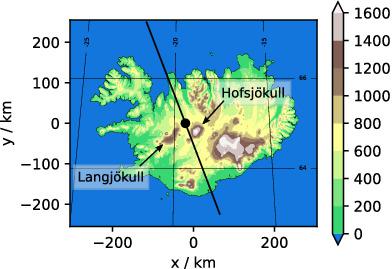当前位置:
X-MOL 学术
›
Q. J. R. Meteorol. Soc.
›
论文详情
Our official English website, www.x-mol.net, welcomes your
feedback! (Note: you will need to create a separate account there.)
Observation and simulation of mountain wave turbulence above Iceland: Turbulence intensification due to wave interference
Quarterly Journal of the Royal Meteorological Society ( IF 3.0 ) Pub Date : 2020-06-19 , DOI: 10.1002/qj.3848 Henrike Wilms 1 , Martina Bramberger 1, 2 , Andreas Dörnbrack 1
Quarterly Journal of the Royal Meteorological Society ( IF 3.0 ) Pub Date : 2020-06-19 , DOI: 10.1002/qj.3848 Henrike Wilms 1 , Martina Bramberger 1, 2 , Andreas Dörnbrack 1
Affiliation

|
The High‐Altitude LOng Range research aircraft (HALO) encountered strong turbulence above Iceland at 13.8 km altitude on 13 October 2016. The generation of turbulence along the flight path is studied through numerical simulations in combination with the aircraft insitu observations. From the insitu observations, maximum energy dissipation rate values (cube root of the energy dissipation rate) of 0.39 m2/3 ·s−1 are obtained, which correspond to moderate to severe turbulence for a medium‐weight aircraft such as HALO. The turbulent region is characterized by observed large‐amplitude vertical wind fluctuations which coincide locally with a stagnation of the horizontal flow. The strong turbulence occurred downstream of and between the two Icelandic mountains Hofsjökull and Langjökull. High‐resolution numerical simulations, with realistic and idealized topography, show that the flow above these two nearby mountains is responsible for the observed turbulence. Vertically propagating hydrostatic mountain waves disperse horizontally in the region downstream and between Hofsjökull and Langjökull. There, both waves interfere and their superposition leads to enhanced amplitudes and, eventually, to convective instabilities. By comparing simulations with only one of the mountains to the simulation with both mountains, we infer that the wave interference can locally amplify the turbulence intensity by a factor of five and double the vertical extent of the turbulent region.
中文翻译:

冰岛上方山浪湍流的观测和模拟:波浪干扰引起的湍流强度
高空长距离研究飞机(HALO)在13以上遇到冰岛强气流13.8公里的高空2016年十月沿航迹湍流的产生是通过结合数值模拟与飞机研究原位观察。从原位观察,最大能量耗散率值0.39米(能量耗散率的立方根)2/3 · š -1获得的值对应于中等重量飞机(如HALO)的中到重湍流。湍流区域的特征是观察到的大振幅垂直风波动,局部与水平流的停滞相吻合。强烈的湍流发生在两个冰岛山霍夫斯库尔和朗格库尔的下游和之间。具有现实和理想地形的高分辨率数值模拟表明,在这两座附近山脉上方的流动是观测到的湍流的原因。垂直传播的静水波在水平区域内以及霍夫舍湖和朗戈库尔之间水平扩散。在那里,两个波都相互干扰,并且它们的叠加导致振幅增大,并最终导致对流不稳定性。
更新日期:2020-06-19
中文翻译:

冰岛上方山浪湍流的观测和模拟:波浪干扰引起的湍流强度
高空长距离研究飞机(HALO)在13以上遇到冰岛强气流13.8公里的高空2016年十月沿航迹湍流的产生是通过结合数值模拟与飞机研究原位观察。从原位观察,最大能量耗散率值0.39米(能量耗散率的立方根)2/3 · š -1获得的值对应于中等重量飞机(如HALO)的中到重湍流。湍流区域的特征是观察到的大振幅垂直风波动,局部与水平流的停滞相吻合。强烈的湍流发生在两个冰岛山霍夫斯库尔和朗格库尔的下游和之间。具有现实和理想地形的高分辨率数值模拟表明,在这两座附近山脉上方的流动是观测到的湍流的原因。垂直传播的静水波在水平区域内以及霍夫舍湖和朗戈库尔之间水平扩散。在那里,两个波都相互干扰,并且它们的叠加导致振幅增大,并最终导致对流不稳定性。











































 京公网安备 11010802027423号
京公网安备 11010802027423号